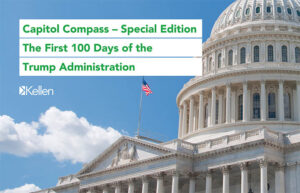Updated July 9, 2025 | Written by Kellen Staff
Updates on Tariff Actions
July 9, 2025: Today, the Trump administration announced that the implementation of new global reciprocal tariff rates, initially scheduled for July 9, will take effect on August 1, allowing additional time for negotiations. Introduced as part of the “Liberation Day” trade initiative, these tariffs impose country-specific rates ranging from 25% to 40% on 14 nations, including Japan, South Korea, Malaysia, and Thailand. The Executive Order does not affect existing tariffs on imports from China, which remain under separate designations. Over the past week, President Trump has sent formal notification letters to the affected countries, signaling that these tariffs will take effect on August 1 unless bilateral agreements are finalized. The White House released a fact sheet detailing the specific tariff levels by country. Additionally, the Commerce Department shared procedures for companies seeking to be included or excluded from the new tariffs, with eligibility based on supply chain, origin, and national security criteria. Finally, President Trump announced that countries aligning with BRICS “anti-American policies” could face an added 10% tariff. While no official policy has been issued, the post reflects earlier threats tied to BRICS discussions on forming a joint currency.
May 29, 2025: A federal appeals court lifted the first of two rulings blocking President Trump’s tariffs, granting a temporary stay. The appeals court set a briefing schedule through June 9 for the parties to present their arguments, after which the court will rule on whether to grant a longer pause.
May 29, 2025: Yesterday, the U.S. Court of International Trade blocked President Trump’s ability to impose his tariffs on U.S. trading partners, ruling he overstepped his legal authority under federal law. The decision by a panel of federal judges was in response to lawsuits filed by small businesses and several states, which argued the tariffs were unconstitutional and lacked precedent. The court found President Trump lacked the legal power to impose broad global tariffs under the International Emergency Economic Powers Act (IEEPA) of 1977, emphasizing the law does not grant the president unlimited authority to regulate imports. The ruling gave the executive branch up to 10 days to complete the process of halting the tariffs. A White House spokesman sharply criticized the court’s ruling, saying, “It is not for unelected judges to decide how to properly address a national emergency,” he said, adding that Mr. Trump would use “every lever of executive power to address this crisis.” The Trump administration announced plans to appeal the decision, which could impact existing trade negotiations and agreements with countries such as the U.K. and China.
May 25, 2025: Following a request from European Union (EU) Leaders, for more time to negotiate a trade deal, and a conversation with to Ursula von der Leyen, president of the European Commission, for more time to negotiate a trade deal, President Donald Trump announced today he would delay imposing new tariffs on all imports from the EU until July 9, 2025. The move helps to ease trade tensions between the two and briefly boosts U.S. markets.
May 12, 2025: At a press conference in Geneva, the United States and China officials announced an agreement to reduce most of the recently imposed tariffs and implement a 90-day pause in their ongoing trade dispute to allow for further negotiations. Financial markets responded positively to the development, which helped ease concerns over global economic instability. As part of the agreement, the United States will reduce its tariff rate on Chinese imports from 145% to 30%, while China will lower its tariff rate on U.S. goods from 125% to 10%.
May 8, 2025: Today, President Donald Trump and UK Prime Minister Keir Starmer announced a new, “full and comprehensive” trade agreement between the United States and the United Kingdom. The agreement aims to strengthen transatlantic economic relations by lowering tariffs on British steel, aluminum, and automobiles while expanding market access for key U.S. agricultural exports, including beef. The UK will join a broader U.S. economic security framework as part of the agreement, deepening collaboration in advanced technology and defense. While still being finalized, this deal intends to drive job creation, boost investment, and promote sustained economic growth in both nations.
April 10, 2025, 5:00 PM ET: Yesterday, President Trump announced he was enacting a 90-day pause for the reciprocal tariffs, as noted in a post on Truth Social. Along with pausing the reciprocal tariffs and lowering the rate to 10%, he announced an increase in the tariff rate for China to 125%, effective immediately. The White House also published an executive order regarding the amended reciprocal tariffs, which notes the pause of 90 days following outreach from “more than 75 other foreign trading partners, including countries enumerated in Annex I to Executive Order 14257.” As noted in the order, the 90-day pause would delay enforcement of the reciprocal tariffs until July 9, 2025, and these countries would be subject to the 10% baseline rate. Of note, as the U.S. implemented an additional 20% tariff on China due to concerns around fentanyl, the total tariff rate for China is 145%, as noted by a White House official. The executive order also stated the U.S. would apply tariffs on small parcels previously exempt from duties. Starting May 2, the U.S. will tax imports of shipments priced up to $800 at a rate of 120%. The U.S. will also increase the per postal item fee on goods between May 2 and June 1 to $100. This escalation towards China follows a back-and-forth between the two nations, which saw each raising levies over the past week, with China announcing plans yesterday to raise the rate on U.S. imports to 84%.
While there is the 90-day pause to move non-exempt countries besides China to a 10% tariff rate, the other tariffs which have been implemented remain in place, including the 25% tariff on autos, the 25% steel and aluminum tariffs, and the 25% tariffs on non-U.S.-Mexico-Canada Agreement (USMCA) compliant goods from Canada and Mexico. In comments made after the announcement to reporters, President Trump noted he may look at tariff exemptions for some companies. He had previously indicated there would be no exemptions or exclusions, though there are different opinions amongst his Cabinet and advisors on the possible use of exemptions. The president also acknowledged that the volatility of the markets following the tariff announcements and implementation played a role in his decision to pause the reciprocal tariffs.
The president and administration officials indicated the pause allows countries to negotiate with the U.S. on trade deals, which could result in those countries not facing higher duties following the 90-day pause if they decrease their tariffs on the U.S. or remove other non-tariff barriers. Many countries welcomed the pause for reciprocal tariffs, particularly those facing higher duties, including Malaysia, Vietnam, South Korea, and Thailand. However, even with the pause, uncertainties remain, which will continue to impact markets and may even impact negotiations on trade deals between countries and the U.S., particularly if the U.S. is not viewed as a reliable trading partner.
April 2, 2025, 5:00 PM ET: President Trump officially announced reciprocal tariffs for imports from 60 countries, including several long-standing allies, as well as a baseline 10% tariff for all imports, declaring a national economic emergency. The president emphasized that while these tariffs will not be fully reciprocal, they aim to achieve a “fair” balance. A baseline 10% minimum tariff was introduced for all imports, and then higher reciprocal tariff rates will be applied for those countries with larger trade surpluses with the U.S., including a 34% rate for China, a 20% rate for the European Union, a 25% rate for South Korea, a 24% rate for Japan, and a 32% rate for Taiwan. These reciprocal tariffs will take effect on April 9 at 12:01 AM ET, and the baseline tariffs will go into effect on April 5 at 12:01 AM ET. In addition, the administration will impose a 25% tariff on all foreign-made automobiles starting April 3 at 12:01 AM ET. Additional import taxes will also be levied on cars, semiconductors, and pharmaceuticals—these taxes will be applied “on top of” the reciprocal tariffs. President Trump indicated that countries wishing to avoid these measures could choose to manufacture their products within the United States. This announcement represents a significant escalation in the ongoing trade tensions, with broad potential consequences for global trade and economic stability. The new tariffs will impact key industries, including agriculture, manufacturing, and the medical sector. Notably, the administration announced that it will continue the U.S.-Mexico-Canada Agreement (USMCA) exemption for Canada and Mexico tariffs, so neither country will be subject to the reciprocal tariffs. White House Fact Sheet.
March 4, 2025, 12:01 AM ET: President Trump officially imposed a 25% tariff on nearly all goods imported from Mexico and Canada, alongside an additional 10% tariff on goods from China. As the top three export markets for the United States, these countries accounted for more than 40% of total U.S. imports last year. The imposition of these tariffs marks a significant escalation in trade tensions. It has triggered a reciprocal trade war, which could have widespread economic consequences, impacting agriculture and manufacturing industries. In response, China, and Canada swiftly retaliated, announcing their own tariffs on U.S. goods. China will impose tariffs on $21 billion worth of American agricultural and food products, including 15% tariffs on chicken, wheat, corn, and cotton, as well as 10% tariffs on imports of sorghum, soybeans, pork, beef, seafood, fruits, vegetables, and dairy products. Beijing has also imposed export and investment restrictions on 25 U.S. companies on the grounds of national security. Canada also announced 25% tariffs on $30 billion worth of U.S. goods just after midnight, though it has yet to specify which products are affected. Mexico is expected to announce its response later today.
Feb. 28, 2025, 12pm ET: After a one-month pause, tariffs, a signature part of Trump’s campaign, are set to take effect beginning March 4. The President is promising a 25% tariff on goods from Canada and Mexico and an additional 10% on goods from China. The taxes will impact over $1 trillion of imports and likely start a trade war in retaliatory tariffs. The President has claimed that Canada, Mexico, and China have allowed illicit drugs and illegal immigrants into the U.S., and the tariffs are meant to spur an increase in North American border security and crackdown on the illegal fentanyl trade in China.
Feb. 13, 2025, 2pm ET: President Donald Trump unveiled a plan today to raise tax rates on imports from other countries in an effort to eliminate trade imbalances. The tariffs, enacted via executive action, could boost U.S. revenue but may spark a global trade war and exacerbate rising inflation. These reciprocal tariffs target countries imposing import duties on U.S. goods, adding to the 25% tariffs on steel and aluminum and a 10% across-the-board tariff announced earlier this week. The tariffs will not take effect immediately, allowing nations time to negotiate new trade terms with the U.S., according to a White House official.
Feb. 10, 2025, 6pm ET: President Trump today announced a 25% tariff on all steel and aluminum imports, including finished metal products. The new tariffs will apply to all trading partners, with no exemptions, including Canada and Mexico, the United States’ top two foreign suppliers of these metals. This move follows last week’s 10% tariffs on goods from China and the currently suspended 25% levies on Canada and Mexico. Additionally, the president has outlined plans for reciprocal tariffs against other nations. The tariffs were approved under Section 232 of the Trade Expansion Act, which grants the president broad authority to impose trade restrictions for national security reasons. Trump had previously invoked this same provision to implement steel and aluminum tariffs during his first term in office.
Feb. 4, 2025, 9am ET: The United States imposed a 10% tariff on Chinese imports starting today. In response, China retaliated with targeted tariffs and issued warnings to several U.S. companies, including Google, about potential sanctions. President Trump is scheduled to speak with Chinese President Xi Jinping in the coming days.
Feb. 3, 2025, 5pm ET: After discussions with Mexican President Claudia Sheinbaum and Canadian Prime Minister Justin Trudeau, President Donald Trump announced a 30-day delay in imposing tariffs on Mexico and Canada. This delay follows agreements by both neighboring countries to enhance border security efforts. As of this posting, tariffs on China remain in effect and are scheduled to take effect on Tuesday.
What Happened?
On Saturday, February 1st, the White House officially announced that President Donald Trump would impose new tariffs on Canada, Mexico, and China. Senior figures on Capitol Hill were briefed on the decision.
Trump is imposing a 25% tariff on imports from Canada and Mexico and a 10% additional tariff on imports from China. Energy resources from Canada will have a lower 10% tariff.
The White House fact sheet is available here.
On What Authority did the President do This?
Citing an emergency situation from the extraordinary threat posed by undocumented immigrants and illegal drug trafficking, including fentanyl, the President exercised his authority under the International Emergency Economic Powers Act (IEEPA) to impose tariffs on Mexico, Canada, and China. This is an unprecedented action under the IEEPA, and it is unchartered legal territory.
The Executive Orders were published on February 1, 2025.
When Will this Take Effect? For How Long?
The tariff actions against Mexico, Canada, and China will begin on February 4, 2025.
It is unclear how long the tariffs will be imposed. The order notes that the tariffs will be removed when the flow of migrants and illegal fentanyl into the United States is alleviated.
What was the Response?
Both Canadian Prime Minister Justin Trudeau and Mexican President Claudia Sheinbaum announced counter-tariffs on Saturday.
Canada will impose 25% tariffs on $155 billion worth of U.S. goods, starting with $30 billion on Tuesday and followed by $125 billion in 21 days.
Mexico plans retaliatory “tariff and non-tariff measures,” in retaliation for Trump’s move, but the potential scope was not clear.
China said it would file a legal case against the United States at the World Trade Organization and vowed to take “corresponding countermeasures” without offering details.
Reactions from the business, manufacturing, and building trades were swift and harsh.
See a sampling of statements from the U.S. Chamber of Commerce, the National Association of Manufacturers, the National Association of Home Builders, and the Distilled Spirits Council.



